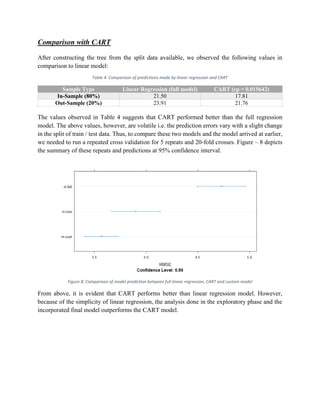This document analyzes factors affecting housing prices in Boston suburbs using linear regression. Exploratory data analysis identifies relationships between variables and transforms some to better fit linear models. Variable selection methods identify the best predictors. A customized model with transformed variables and interaction terms outperforms other models with an adjusted R-squared of 0.85. While CART predicts better than linear regression alone, the customized linear model incorporates more information from exploratory analysis to perform best overall.

![Table of Contents
Executive Summary - Boston Housing Data.................................................................................................2
Boston Housing Data.....................................................................................................................................3
Introduction ..............................................................................................................................................3
Exploratory Data Analysis .........................................................................................................................3
Variable Selection and Modelling .............................................................................................................7
Residual Diagnostics .................................................................................................................................9
Final Model ...............................................................................................................................................9
Comparison with CART ...........................................................................................................................10
Executive Summary - Boston Housing Data
This report provides an analysis and evaluation of the factors affecting the median value of the
owner occupied homes in the suburbs of Boston. The in-built data set of Boston Housing Data is
used for this analysis and various factors about the structural quality, neighbourhood,
accessibility and air pollution such as per capita crime rate by town, proportion of non-retail
business acres per town, index of accessibility to radial highways etc are taken into account for
this study.
Methods of analysis include (but not limited to) summary statistics and visualization of the
distribution of the variables, finding correlation between variables and conducting linear
regression on the data.
Further, various variable selection methods like Best Subset, Stepwise Selection and LASSO was
performed to come up with the best linear regresssion model to predict the median value of the
owner occupied homes. These models were then compared with a custom model designed after
including all the analysis from the initial exploration.
Finally, a comprehensive comparison was made between linear regression and CART to predict
the median price values after supplying the same data. The results indicated that while CART
outperformed linear regression, the additional details captured by the linear regression model in
the exploratory phase was still a better choice.
The final model included interaction term and variable transformation. This model resulted in an
adjuted R-squared value of 0.85 and an avg MSE value of 3.60
medv ~ nox + ptratio + age + [log(lstat) + rm + log(crim) + dis] * rad_c](https://image.slidesharecdn.com/bostonhousing-180313065030/85/Regression-Study-Boston-Housing-2-320.jpg)







